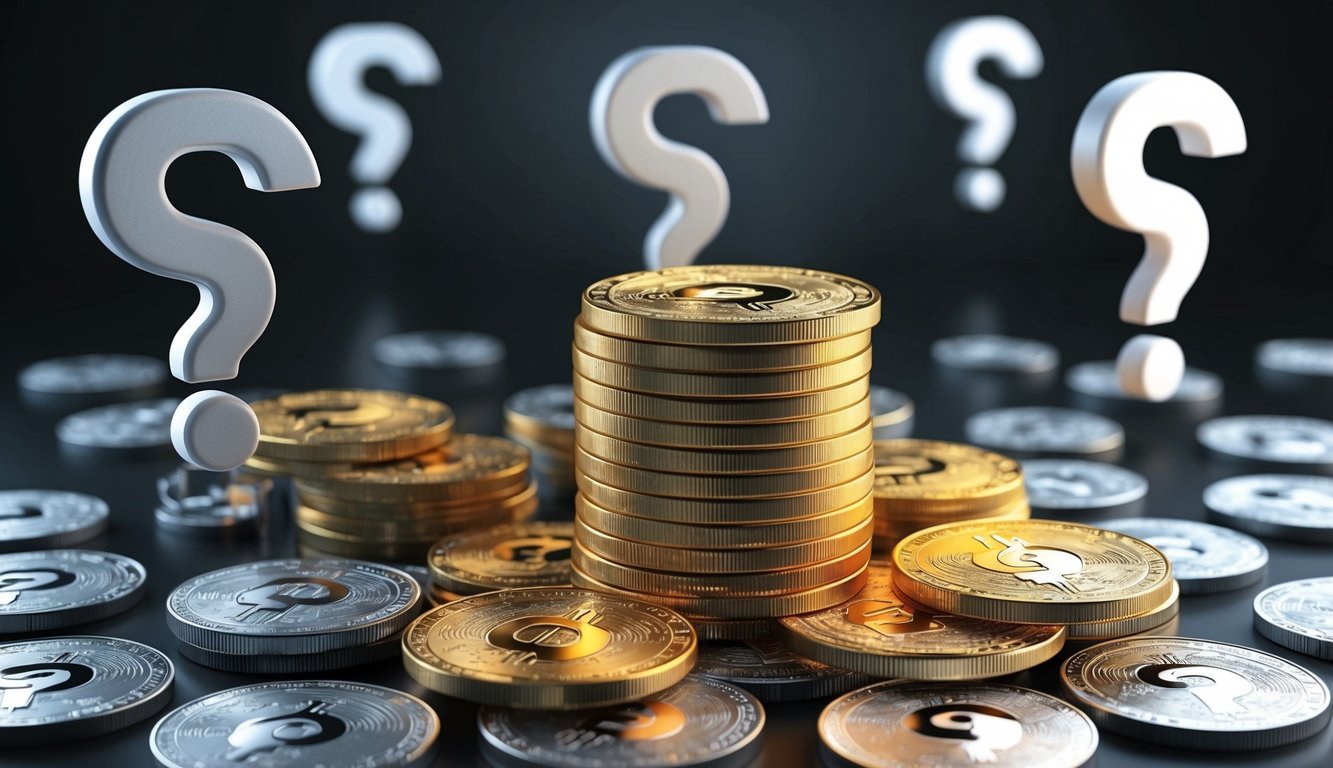Imagine buying a pizza with digital coins that exist only on the internet. That’s what cryptocurrency is all about. It’s a type of digital money that works without banks or governments. Cryptocurrency uses special computer codes to keep transactions safe and create new units.

You might have heard of Bitcoin, the most famous cryptocurrency. But there are many others too. These digital coins use a system called blockchain to keep track of who owns what. It’s like a big public record book that everyone can see but no one can cheat.
People use cryptocurrencies to buy things, save money, or try to make a profit by trading. Some think it’s the future of money, while others worry it’s too risky. As more people learn about it, cryptocurrency keeps changing how we think about money in the digital age.
Key Takeaways
- Cryptocurrency is digital money that uses code to secure transactions
- It works on a system called blockchain, which keeps a public record of all trades
- You can use cryptocurrency to buy things, save, or trade for potential profit
Understanding the Basics
Cryptocurrency is digital money that uses complex tech to keep it secure. It’s not controlled by banks or governments. Let’s explore how it works and some popular types.
What Is Cryptocurrency?
Cryptocurrency is internet money you can’t hold in your hand. It’s all digital. You can use it to buy stuff or trade it for profit.
Bitcoin was the first crypto, made by someone called Satoshi Nakamoto. No one knows who that really is.
Crypto uses special math to keep your money safe. It’s stored on many computers, not in a bank.
You can buy crypto on websites called exchanges. Then you keep it in a digital wallet.
How Does Blockchain Technology Work?
Blockchain is the tech that makes crypto work. It’s like a big digital book that everyone can see.
When you make a trade, it gets added to this book. The book is copied on lots of computers.
This makes it super hard to cheat or hack. Once something’s in the book, you can’t change it.
Blockchain doesn’t just work for money. People use it for other stuff too, like tracking products.
Types of Cryptocurrencies: Beyond Bitcoin
Bitcoin is the most famous crypto, but there are many others. These are called altcoins.
Ethereum is a big one. It’s not just money – you can build apps on it.
Tether is a “stablecoin.” Its value is tied to real money to keep it steady.
Solana is known for being fast and cheap to use.
There are thousands of cryptos. Some are serious projects, others are more like jokes. Always research before you buy any.
Using Cryptocurrency
Cryptocurrency offers new ways to buy, spend, and invest money. It can change how you handle finances and open up fresh opportunities.
Buying and Storing Cryptocurrencies
To start using crypto, you need to buy some first. You can get cryptocurrency from exchanges. These are online platforms where you trade regular money for digital coins.
Once you have crypto, you need a safe place to keep it. This is where crypto wallets come in. There are two main types:
- Software wallets: Apps on your phone or computer
- Hardware wallets: Physical devices that look like USB sticks
Software wallets are easy to use but less secure. Hardware wallets are safer but cost more. Pick the one that fits your needs best.
Crypto Transactions: A New Financial Freedom
Using crypto for purchases is getting easier. More shops now take digital money. You can buy things online or in stores with crypto.
To make a payment, you’ll use your crypto wallet. It’s like sending an email, but with money. You type in the receiver’s address and hit send. The money moves fast, often in minutes.
Crypto lets you send money worldwide without banks. This can be cheaper and quicker than old ways of moving cash. It’s great for people who travel or have family in other countries.
Investing in Digital Assets
Many see crypto as a way to grow their money. But it’s risky – prices go up and down a lot. You need to be careful and only use money you can afford to lose.
There are different ways to invest:
- Buy and hold: Get crypto and wait for it to go up in value
- Trading: Buy and sell often to make quick profits
- Staking: Earn rewards by holding certain types of crypto
Before you invest, learn about the coins you’re interested in. Look at their tech, team, and real-world use. This helps you make smarter choices with your money.
The Market Dynamics of Cryptocurrencies

The crypto market is a wild ride. It’s known for big swings in prices and changing rules. Let’s look at what drives this market and how it works.
Volatility and Market Capitalization
Crypto prices can change a lot in a short time. This makes the market exciting but risky. Bitcoin, the biggest crypto, can lose or gain thousands of dollars in value in just one day.
The total value of all cryptocurrencies, called market capitalization, changes often. In 2017, it hit $100 billion for the first time. Now, it’s much higher.
Why so much change? News about rules, big companies buying in, or tech updates can all affect prices. This keeps traders on their toes and makes long-term planning tricky.
Trading and Exchanges
You can buy and sell crypto on special websites called exchanges. These work a bit like stock markets, but for digital money. Some big names are Coinbase and Binance.
Trading crypto is different from regular money. You can trade 24/7, and prices can change fast. This means you might make or lose money quickly.
Many people use apps to trade on their phones. This makes it easy to buy or sell anytime. But it also means you need to be careful and watch your investments closely.
Regulation and Compliance
Rules for crypto are still new and changing. Different countries have different ideas about how to handle it. This can make things confusing for traders and businesses.
The Financial Action Task Force (FATF) is trying to make global rules. They want to stop crypto from being used for bad things like crime.
In Europe, a new law called Markets in Crypto-Assets (MiCA) is coming. It will set rules for how crypto companies work. This might make crypto safer but also change how the market works.
As rules change, you’ll need to stay updated. What’s okay today might not be tomorrow. Always check the latest rules before you trade or use crypto.
Technical Mechanics and Security
Cryptocurrency relies on complex tech to keep your digital money safe and working smoothly. Let’s look at how cryptography protects your coins and how mining makes the whole system tick.
Cryptography and Network Security
Cryptography is the secret sauce that keeps your crypto safe. It uses public and private keys to secure your transactions. Your public key is like your bank account number – you can share it. But your private key is like your password – keep it secret!
When you send crypto, you “sign” the transaction with your private key. This proves it’s really you. The network then checks this signature with your public key. It’s like magic – only you can make the signature, but anyone can check it’s legit.
The blockchain, a shared record of all transactions, adds another layer of security. It’s super hard to hack because it’s spread across many computers. This setup makes crypto tough to mess with.
Mining and Consensus Mechanisms
Mining is how new coins are made and transactions are confirmed. Miners use powerful computers to solve tricky math problems. When they crack the code, they get to add a new block to the blockchain and earn some coins.
There are different ways to agree on which transactions are legit. Proof-of-work is the OG method used by Bitcoin. It’s like a race – the first miner to solve the puzzle wins. But it uses a ton of energy.
Proof-of-stake is the new kid on the block. Instead of racing to solve puzzles, you “stake” your coins as collateral. The more you stake, the more likely you are to be picked to validate transactions. It’s way more energy-efficient.
These systems make sure everyone agrees on the state of the network. They prevent cheating and keep your crypto transactions running smoothly.
Frequently Asked Questions

Crypto can seem confusing at first. Let’s clear up some common questions about how it works, getting started, mining, trading, and the pros and cons.
How does cryptocurrency work?
Crypto uses blockchain technology to create digital money. It’s not controlled by banks or governments. Instead, a network of computers keeps track of all transactions.
When you buy crypto, you get a digital wallet. This holds your coins or tokens. You can use them to buy things or send money to others.
What’s the first step for beginners interested in crypto?
Start by learning the basics. Read about different coins like Bitcoin and Ethereum. Pick a reputable exchange to buy your first crypto.
Set up a secure digital wallet to store your coins. Start with a small amount you can afford to lose. The crypto world changes fast, so keep learning.
Can you explain crypto mining to me?
Mining is how new coins are made. Miners use powerful computers to solve complex math problems. When they solve one, they get new coins as a reward.
Mining helps verify transactions and keep the network safe. It takes a lot of energy and special equipment. Most people don’t mine at home anymore.
What should I know about trading crypto?
Crypto prices can change a lot in a short time. This makes trading risky but potentially profitable. You need to understand the market and have a solid strategy.
Start small and only trade what you can afford to lose. Learn about different coins and market trends. Use reliable exchanges and keep your coins safe.
Are there any benefits to using crypto over traditional money?
Crypto can be sent quickly anywhere in the world. Fees are often lower than bank transfers. You don’t need a bank account to use it.
Some people like that it’s not controlled by governments. It can offer more privacy than regular money. But remember, it’s not completely anonymous.
What are the risks involved with using cryptocurrencies?
Crypto prices can change fast. You might lose money if you buy at the wrong time.
Scams and hacks are common, so you need to be careful. If you lose your wallet key, you can’t get your coins back.
Some countries are still figuring out how to regulate crypto. This can make its future uncertain.




